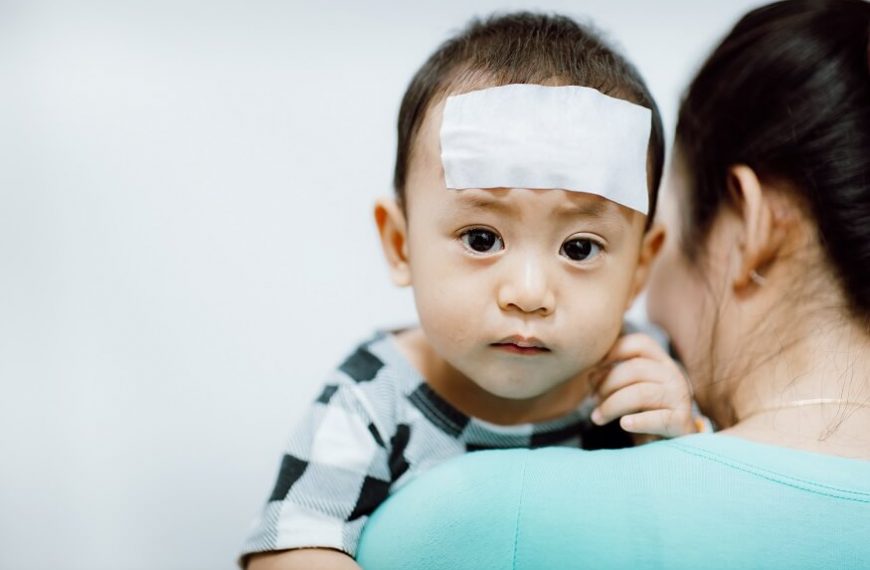Child Head Injuries: Signs, Types, and Risks
Any type of harm to the brain, scalp, skull, or other tissues, as well as blood vessels in the head, constitutes a head injury. Depending on the severity of the injury, a head injury is also frequently referred to as a brain injury or “Traumatic Brain Injury” (TBI).
Even a bruise (contusion), bump, or head cut can result in a brain injury. Alternately, it could result from a concussion, a severe cut or open wound, internal bleeding, shattered skull bones, or brain injury. One of the most frequent causes of disability, as well as mortality in children, is head trauma.
Infants and toddlers frequently bang their heads on furniture, such as tables or headboards or fall from high places, resulting in discomfort and swelling. It will take a lot more than a little bump or a careless fall, though, if you, as a parent, are concerned about a major brain injury.
The Six Warning Signs To Keep An Eye On:
- Fast-Growing Swelling In One Part Of The Head: Children may exhibit “a persistent sudden onset, fast-growing swelling in one part of the head” as a warning sign of a head injury. The doctor suggests taking quick action if it is “growing by the hour” or “disproportionately fast.”
- Persistent Vomiting: Again, if the youngster has been vomiting continuously for the past 24 hours, that might be a symptom. According to the doctor, the vomiting would be “uncontrollable” and “back to back.”
- Drowsiness: Another indicator of tiredness is when a youngster is awake but has trouble getting themselves up and continues falling.
- Wavering-Walking: Additionally, after a fall or collision, youngsters who exhibit unsteady walking should be watched out for. Due to this, your youngster can have trouble walking straight and might continually tumble from one side to the other.
- Blood Or Clear Fluid From The Nose Or Ear: Blood or clear fluid coming from the nose or ear is one of the warning symptoms of internal brain damage, according to the expert.
- Convulsion: Finally, Dr. Parekh discusses “convulsion,” which is the “biggest red flag” of a brain injury and the most serious. When muscles rapidly contract and release, the result is a convulsion, which results in the body shaking violently. The doctor claims that this is an indication of a subdural haematoma (SDH).
It’s critical that parents maintain their composure. He encourages parents to set an alarm every three to four hours if their child has suffered a brain injury. He advises waking the youngster up at night to check for any indications of significant internal damage.
In order for the pediatrician to determine if the parent has to be “extra-vigilant” for the following 24 hours or not, it is crucial to remain in contact with them and to let them know what kind of damage the kid has sustained.
Types Of Head Injuries Include:
Concussion:
This head injury might temporarily prevent the brain from functioning correctly. This can occasionally lead to a loss of awareness or attention that can last anywhere from a few minutes to many hours. Some concussions are minor and only last a short while, so you might not immediately notice that one has happened.
Contusion:
On the brain, there is a bruise. A contusion results from bleeding and swelling inside the brain around the site of the head injury. Sometimes, the brain striking the skull might result in a contusion on the opposite side of the head. This harm can result from a direct hit to the head, a kid being violently shaken, or a whiplash-like injury from a car accident. The interior lining, tissues, and blood vessels may rupture as a result of the brain banging against the sides of the skull.
Skull Fracture:
A break in the skull bone is known as a skull fracture. Four main categories of skull fractures exist:
- Linear Skull Fracture: This bone break does not cause the bone to move. In the hospital, your kid could be closely observed for a short while. In a few days, he or she may normally resume their regular activities. Usually, no therapy is required.
- Depressed Skull Fracture: With this fracture, the area of the head where the bone was shattered appears recessed. This might occur with or without a scalp cut. Such a skull fracture requires surgery to help treat it if the interior of the skull presses up on the brain.
- Diastatic Skull Fracture: This type of fracture happens where the skull’s sutures meet. These are the ragged lines that converge (fuse) when a youngster develops between the skull bones. The typical suture lines enlarge when there is this kind of fracture. Infants and neonates are more likely to suffer from these fractures.
- Basilar Skull Fracture: This is a fracture in the skull’s base bone. It might result in a severe skull fracture. Children who suffer from this kind of fracture frequently have bruises behind their ears and around their eyes. Additionally, they can have clear fluid coming out of their ears or nose. This is due to a rip in the brain’s covering in that particular area. The hospital may need to keep a careful eye on a youngster who has this fracture.
What Causes A Head Injury In A Child?
Children’s head injuries can have a variety of reasons. Typical reasons include:
- Athletic Injury
- Falling
- Being into a car accident or being hit by a car while walking
- Child Harassment
Which Children Are At Risk For A Head Injury?
Teenagers are at a significant risk of brain injuries. Boys get head traumas twice as frequently as girls. While kids are particularly active outside, such as while riding bikes, roller skating, or skateboarding, head injuries are more frequent in the spring and summer. Children who participate in contact sports like basketball, hockey, football, and soccer are also more susceptible to concussions.
What Are Possible Complications Of A Head Injury In A Child?
The brain is a fragile and squishy organ. Even if there are no outward symptoms of trauma to the scalp or face, a severe blow to the head can cause damage to the brain or spinal cord. All brain injuries are thus regarded as serious and should be examined by your doctor or the emergency room of the closest hospital.
Children who experience serious brain damage may experience loss of taste, vision, hearing, speech, or muscular function. This is dependent on the location of the injured brain. Changes in behavior or personality might be long-term or short-term. These kids require ongoing medical care and rehabilitation. This might involve speech, occupational, or physical therapy. A child’s recovery after a head injury is influenced by the kind of damage and any underlying medical conditions that could be present.
Disclaimer: The information provided on this website is not a substitute for professional medical advice. EuroKids encourages you to consult with a qualified healthcare professional for any health concerns you may have. The information on this website is not intended to diagnose, treat, cure, or prevent any disease.
















